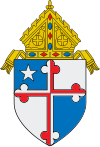
The Metropolitan Archdiocese of Philadelphia is a Latin Church ecclesiastical territory, or diocese, of the Catholic Church in southeastern Pennsylvania in the United States.

The Metropolitan Archdiocese of Baltimore is the archdiocese of the Latin Church of the Catholic Church in northern and western Maryland in the United States. It is the metropolitan see of the Ecclesiastical Province of Baltimore.

John Joseph Keane was an Irish-born American prelate of the Roman Catholic Church. He served as the archbishop of the Archdiocese of Dubuque in Iowa from 1900 to 1911. He previously served as bishop of the Diocese of Richmond in Virginia from 1878 to 1888.

Francis Patrick Kenrick was an Irish-born prelate of the Roman Catholic Church who served as the third bishop of the Diocese of Philadelphia in Pennsylvania (1842–1851) and the sixth archbishop of the Archdiocese of Baltimore in Maryland(1851–1863).

Patrick John Ryan was an Irish-born prelate of the Catholic Church. He served as the second Archbishop of Philadelphia from 1884 until his death in 1911.

Patrick Augustine Feehan, was an Irish-born American prelate of the Roman Catholic Church. He served as the first archbishop of the newly elevated Archdiocese of Chicago in Illinois between 1880 and his death in 1902. He previously served as bishop of the Diocese of Nashville in Tennessee from 1865 to 1880.
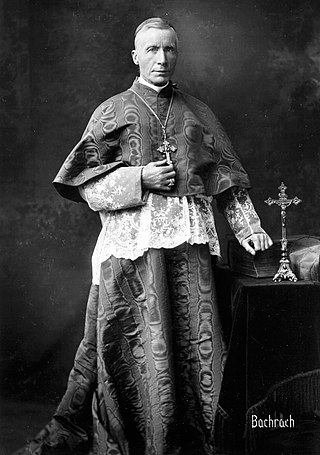
James Cardinal Gibbons was a senior-ranking American prelate of the Catholic Church who served as apostolic vicar of the Apostolic Vicariate of North Carolina from 1868 to 1872, bishop of the Diocese of Richmond in Virginia from 1872 to 1877, and as ninth archbishop of the Archdiocese of Baltimore in Maryland from 1877 until his death. He was elevated to the rank of cardinal in 1886.
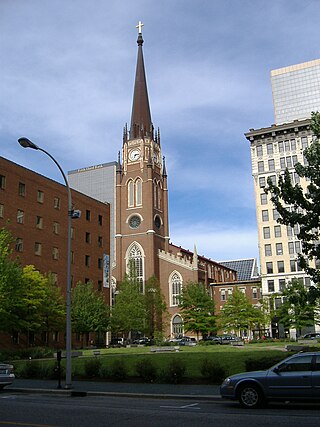
The Archdiocese of Louisville a Latin Church ecclesiastical territory, or archdiocese, of the Catholic Church in central Kentucky in the United States. The cathedral church of the archdiocese is the Cathedral of the Assumption in Louisville, Kentucky. The archdiocese is the seat of the metropolitan see of the Province of Louisville, which encompasses the states of Kentucky and Tennessee. The archdiocese is the second-oldest diocese west of the Appalachian Mountains, after the Archdiocese of New Orleans. As of 2023, the archbishop of Louisville is Shelton Fabre.

John Hennessy was a 19th-century Irish-born prelate of the Roman Catholic Church who served as bishop and archbishop in the United States. He served as bishop and then the first archbishop of the Archdiocese of Dubuque, Iowa, from 1866 to 1900.
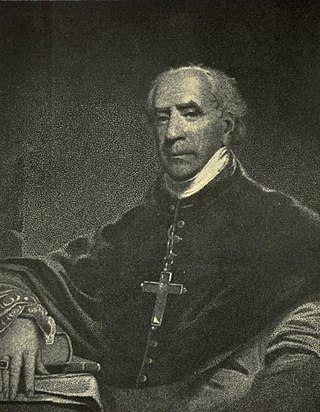
Henry Conwell was an Irish-born Catholic bishop in the United States. He became a priest in 1776 and served in that capacity in Ireland for more than four decades. After the Pope declined to appoint him Archbishop of Armagh, the diocese in which he served as Vicar General, he was instead installed as the second Bishop of Philadelphia in 1819.

The Diocese of Trenton is a Latin Church ecclesiastical territory, or diocese, of the Catholic Church in central New Jersey in the United States. It is a suffragan diocese in the ecclesiastical province of the metropolitan Archdiocese of Newark.

The Diocese of Camden s is a Latin Church diocese of the Catholic Church in the U.S. state of New Jersey. It consists of 62 parishes and about 475,000 Catholics in the South Jersey counties of Atlantic, Camden, Cape May, Cumberland, Gloucester, and Salem.
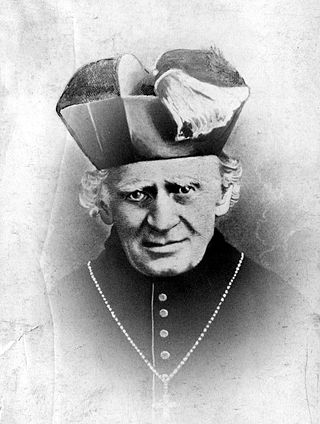
Peter Richard Kenrick was an Irish Catholic priest who served as Bishop of St. Louis from 1843 to 1895. The see was made an archdiocese in 1847, when he was called as the first archbishop west of the Mississippi River. The archdiocese covered nearly all the territory of the Louisiana Purchase. He served in this position for nearly 50 years, until months before his death.

Samuel Eccleston, P.S.S. was an American prelate of the Roman Catholic Church who served as the fifth Archbishop of the Archdiocese of Baltimore, Maryland from 1834 until his death in 1851.

Martin John Spalding was an American prelate of the Roman Catholic Church. He served as bishop of the Diocese of Louisville in Kentucky (1850–1864) and as archbishop of the Archdiocese of Baltimore (1864–1872). He advocated aid for freed slaves following the American Civil War. Spalding attended the First Vatican Council, where he first opposed, and then supported, a dogmatic proclamation of papal infallibility.

Denis J. O'Connell was an Irish-born American prelate of the Roman Catholic Church. He served as bishop of the Diocese of Richmond in Virginia from 1912 to 1926. He previously served as an auxiliary bishop of the Archdiocese of San Francisco in California from 1908 to 1912.

Jean Marcel Pierre Auguste Vérot, known commonly as Augustin Vérot was a French-born American prelate of the Catholic Church who served as the first bishop of the Diocese of St. Augustine in Florida (1870–1876).
In the Roman Catholic Church, a plenary council is any of various kinds of ecclesiastical synods, used when those summoned represent the whole number of bishops of some given territory. The word itself, derived from the Latin plenarium, hence concilium plenarium, also concilium plenum. Plenary councils have a legislative function that does not apply to other national synods.

John Carroll was an American prelate of the Catholic Church who served as the first bishop of the Diocese of Baltimore, the first diocese in the new United States. He later became the first archbishop of Baltimore. Until 1808, Carroll administered the entire American Catholic Church.
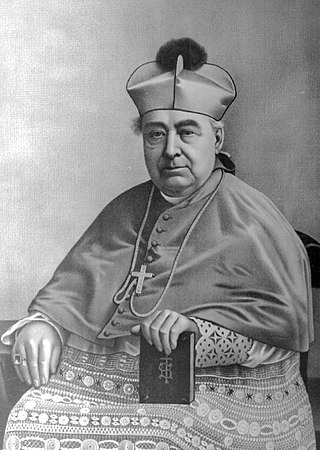
William O'Hara was an Irish-born American prelate of the Catholic Church. He was the first bishop of the Diocese of Scranton in Pennsylvania, serving from 1868 until his death in 1899. He founded St. Thomas College in 1888.




















